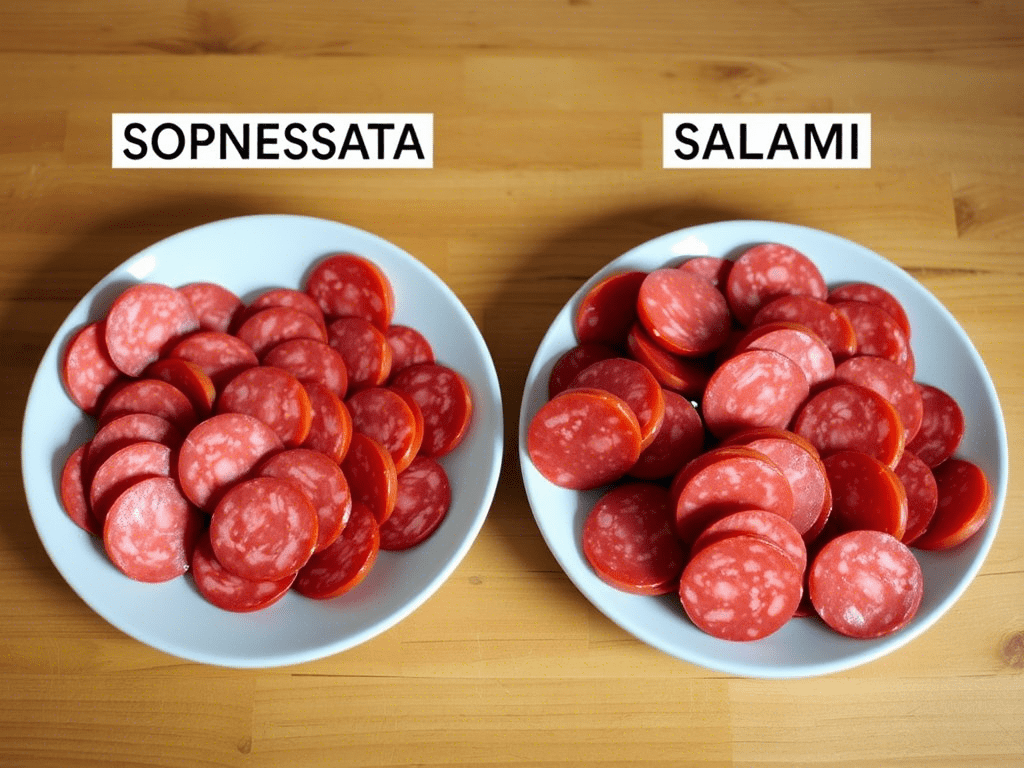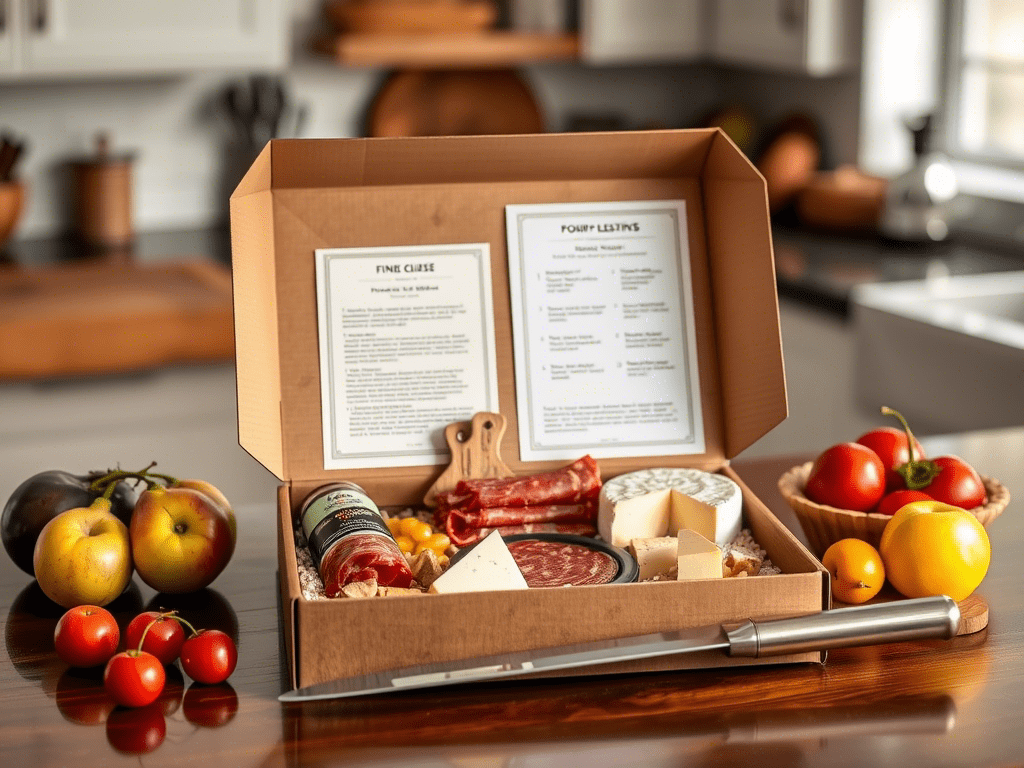7 Bold Reasons to Love Soppressata: The Underrated Star of Italian Cured Meats
While looking through a deli’s offerings or admiring a beautifully arranged charcuterie board, you may have encountered soppressata–that exquisitely marbled, flavorful slice of Italian ingenuity.
Is it another variety of salami, or is there more to the story of soppressata? This spiced treat, whether referred to as soppressata salami, supersod meat, or simply rustic Italian cold cut holds its ground atop of appetizers and morsels around the world.
In this guide, we will discuss what makes soppressata stand out, how it is different from other meats like salami, and what stirred the excitement of food enthusiasts and charcuterie aficionados.
Table of Contents
What is Soppressata?
Essentially, soppressata is a traditional, authentic Italian meat delicacy that is handcrafted by hand in different ways in each Italian region. Unlike industrial cold cuts, soppressata is made on a smaller scale using selective cuts of pork such as shoulder, ham trimmings, and even leans belly. It is then mixed with salt, cracked black pepper, garlic, and red chili pepper which gives it the hallmark bold tangy bite.

There are mainly two types of Soppressata:
- Dry cured soppressata (common in Northern Italy): this variant is air dried and aged for many weeks until it becomes firm, dense, and savory.
- Pressed fresh soppressata (popular in the south): it is made out of fresh pork, stuffed into casing, and then gently fermented. The pressing of the pork helps give the meat a more intense flavor.
Soppressata gets its name from the Latin “soppressare,” meaning “to press down” and the description of the pressing technique explains where the term ‘soppressata’ originated from.
In the US, most people refer to it as soppressata salami which makes is justifiable as it looks like salami, but is a bit more rustic in its appearance with larger bits of meat, and more seasoning. It does not matter whether it is refers to as soppressata or supersod meat, one thing is clear: this cold cut knife meat packed in casing has a unique taste that offers a patchwork of flavors, vivid in taste and aroma.
Soppressata vs Salami: What’s the Difference?
At first glance, soppressata and salami may seem to fit into the same category – they are both types of cured meats served thinly sliced and are common across sandwiches and charcuterie boards. However, the differences that set soppressata apart are important and should not be overlooked.

✅ Texture & Appearance:
Soppressata is coarser than salami which has a fine grind and less variable appearance. Moreover, soppressata may appear flatter due to the pressing method utilized in it’s southern varieties. Additionally, bigger pieces of meat and fat are more easily discernible in soppressata.
✅ Flavor Profile:
Message from Soppressata does not lack boldness. It is spicier than most salami due to added garlic, black pepper and crushed red pepper. In addition, some varieties have a deeper fermented tang. While flavorful, salami has milder taste and is and is slightly sweeter compared to soppressata.
✅ Preparation Style:
Both soppressata and salami undergo curing, but soppressata is more artisanal and traditional, incorporating pressing, hanging, and weeks of aging. Different brands follow different styles, and some opt for a more commercialized and streamlined approach to salami production.
To sum up, soppressata versus salami is more than just a case of misplaced labels; it involves matters of gastronomic appreciation. Both options have their own delectable sides, but soppressata is catered for bolder palates seeking a more rustic taste.
How Soppressata Is Made
The craft of making soppressata combines art, nurturing, and a hint of heat. It does not matter if the soppressata originates from an Italian village or is handcrafted by artisans abroad, the essential method is remarkably similar.
🔪 1. The Meat Selection
Every session begins with high-quality pork shoulder or sometimes even a mix of lean and fatty cuts. It is first coarse ground as opposed to fine grinding done for salami, and this is done to preserve the texture of the meat.
🧂 2. Seasoning
Together with the meat, salt, black pepper, garlic, and red chili flakes are added. Depending on some regional variations, fennel seeds, paprika, or even wine may be added to deepen the flavor.
🌡️ 3. Stuffing & Pressing
Natural casings are filled with seasoned pork. In southern Italy, the stuffed pork is then pressed between wooden boards or weighted slabs, giving it a signature flatter shape. This also increases its firmness.
💨 4. Drying & Aging
In a cool and humid place, dry-cured versions are hung. They lose moisture over several weeks, and at times even month, this leads to flavor development.
🔁 Optional Fermentation
Certain versions undergo fermentation helping to preserve the soppressata while adding a tangy kick.
Such handcrafted practices are what makes soppressata different from the industrialized packaged deli meats we have today. It is more than just aged pork; it is a centuries-old handcrafted tradition.
Taste Profile & Texture
Think of a slice of cured meat like a piece of rustic art – striking and unforgettable. This Italian delicacy does the exact same thing. Each bite comes with a journey. At first, you taste the savory part, slightly salty. Then slowly it reveals the rest of the layers – mild tang, a hint of smoke, and in some cases, soothing chili spiciness that stays in the mouth.
🧂 Flavor That Tells a Story
The spices used in curing have an important role in flavor profile. A traditional blend consists of cracked black pepper, garlic, and red chili flakes. The regional recipes are a bit fancier too, using fennel seeds, paprika, or even a splash of red wine. All those things combined together result in an artisanal masterpiece of a rich and robust taste.
The northern parts are renowned for their fancier flavor profile that is slightly sweet and delicately seasoned. The southern parts on the other hand are more spicy and tend to add Calabrian chili peppers for extra heat. The spice fermentation adds a little bit of acidity in some types of this meat which leads to the increased depth and complexity in the dish.
🧈 Usable Grip
It’s not only flavor that separates this meat from the rest; its texture is equally as important. The meat is not pulverized like many deli meats, rather has a coarse grind which allows for a meaty chew. Because this meat is pressed, its shape is slightly flattened which allows it to be tender yet dense. This characteristic means that it can be cleanly sliced and retains its shape on the cutting board.
This meat shines on a piece of crusty bread or beside a chunk of cheese. It does not merely sit there, it transforms any plate that it is placed on by adding character, contrast, and substance.
The meat has a texture that is chewy, firm, yet tender at the same time. It is dense and the pressing process flattens the sausage a little helping with the distinct shape and satisfying mouthfeel.
If you enjoy deep textures and complex flavors, then this cured meat will be right up your alley.
How to Present Like a Professional
With Italian cuisine, the presentation should be simple but extremely classy. Whether you’re preparing for a light meal or arranging a charcuterie board for visitors, the secret to success is allowing the meat to stand on its own—it’s bold, rich, and downright meaty!
🧀 Pair It Right
Semi-hard cheeses go well with provolone, aged cheddar, or even manchego. To really take things to the next level, a smattering of olives and roasted red peppers, seasoned with a touch of olive oil, can do wonders. To soften the creaminess, include some crusty artisan bread or even thin crackers.

🥂 Matching the Mood for the Cocktails
There is a traditional saying ‘ red wine for red meat’. Chianti or Nero d’Avola for example pair excellently with salt and spice. If wine isn’t your thing, then hoppy IPA or even citrus sparkling water will keep everything fresh and lively.
🎁 One Handy Piece of Information
This specially designed compact meat slicer will alleviate your woes, allowing you to serve your guests deli-thin slices right at home. If you’re going to put in the effort to serve for events or frequently, this will ensure an effortless way to up your presentation game.
Pairing Suggestions
Some of the best characteristics of this cured meat is how simply it can be paired with other food items. Whether it is a snack platter or cut meat sandwich, this can go with anything because of its bold and spicy taste.
If you are wondering what is soppressata matched with, start from sharp cheese like pecorino and asiago. These cheeses do not clash with the meat and instead compliment it’s flavor. Also, aged gouda or blue cheese can provide alittle added contrast as well.
When talking about cured meats, it is quite common for people to compare sopressata vs salami and determine which one will work better in their charcuterie setup. The truth is both meats have their flavor; salami’s sweetness and a smooth taste, and soppressata has a rustic and spicy flavor. Even better, you can place them together for a layered board.
If you are looking for something simple yet old fashioned, try a piece of toasted sourdough bread with soppressata salami on top and fig jam and you will see pure magic. While visiting Italian delis or doing shopping online, if you see “supersod meat” do not be shocked, because you are looking at the same delicious meat but with another name.
Where to Purchase Genuine Soppressata (And How It Differs From Salami)
Finding them both in stores and online, the competition is tough. You have soppressata salami and regular salami. Like many other cured meat lovers, I’m sure you have had the query, “Sopressata or salami?” somewhere at the back of your head.
Salami is sweet, milder, and has a smooth textureAgo sopposed to soppressata, which is steamrolled. Soppressata is coarser, spicier, has a rustic charm, and provides an artisanal bite that makes it a step above other meats.
What exactly is soppressata? It’s a traditional Italian dish comprised of garlic, chili flakes, and black pepper. Depending on the region you reside in, it can be either dry-cured or pressed fresh. You might have also heard of it being referred to as supersod, which is an anglicized version of the same yok it.
🛍️ Places You Can Find It
Mass-produced cold cuts are not the answer for how to find quality suprerosehat gsupremose to look for brands specializing in small-batch curing. Farmers’ markets, gourmet grocery stores, and Italian delis have very intriguing selections you should check out.
When shopping online, consider purchasing a curation that contains both salami and soppressata – a curated meat and cheese box. This enables you to experience the palpable difference in flavor right from your kitchen – a miniature sopressata vs. salami tasting party, if you will.
This knowledge, whether it is something spicy and rugged you desire, or smooth and sweet, assists you in selecting the appropriate meat at the most suitable time.

Storage Tips & Shelf Life
Taking care to ensure the soppressata you purchase is fresh is particularly important in making sure it is soppressata di Calabria. Whether the meat is referred to as soppressata salami or even supersod meat, the principles of storage remain quite the same across the board.
🧼 First Things First: Wrap It Right
If still unopened and vacuum sealed, it can last several months in the fridge. Once opened though, it is important to rewrap it in wax paper or butcher paper rather than plastic wrap so that it can breathe. This will help soppressata retain its texture and prevent too much moisture from entering.
🌡️ Where to Store It
Always store it in a refrigerator, preferably in the meat or cheese drawer of the appliance where the humidity levels are stable. If it is a dry cured variety, it can also be stored in a cool pantry for short periods of time (Below 15 ( degree C / 59 ( degree F )).
🕓 Shelf Life Breakdown
Whole soppressata (uncut): 2–3 months refrigerated
Sliced versions: best within 1–2 weeks
Frozen: best up to 6 months, but may affect texture
Still asking what is soppressata? Remember: it’s not just taste, but also tradition — and that implies respect, even in storage. Whether it’s soppressata vs salami or enjoyed solo, proper storage makes every slice perfect.
While exploring online stores, look out for curated meat and cheese boxes that feature salami and soppressata. That way, you can experience the contrast yourself — a mini sopressata vs salami tasting party, if you will.
Knowing the difference between each cut of meat allows you to satisfy a craving for rustic and spicy, or smooth and sweet.
Concluding Considerations
Savoring food that has been meticulously aged, spiced, and crafted with great care comes from more than just consuming; it is partaking in a culture. Whether served thinly sliced on a platter or incorporated into a sandwich, this type of cured meat contributes flavor, sophistication, and a rugged element to your food.
Do not hesitate to mix other types of cured meat with soft cheeses, pickled vegetables, nuts, or even dried fruits. You can serve it in a simple manner such as with a hefty piece of rustic bread, or in a progressive style with a creative sampling board and some wine. It is rewarding, full of character, and a versatile dish.
And hey, if you are one of the people who prefer balancing their indulging portions with fresh meals, this smoothie recipes list is just for you. Wholesome food is not simply about one tone, it is about contrast, balance, and discovering what works best alongside one another.
As you discover new ways to prepare cured meats, be bold and think outside the box.

